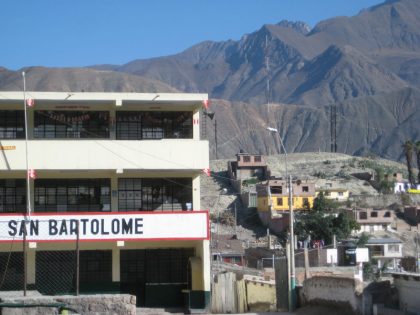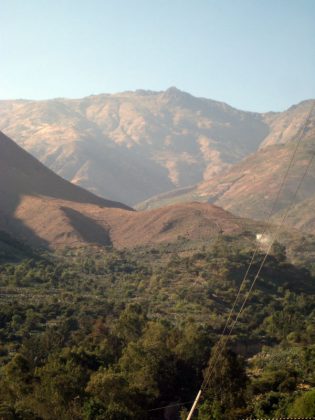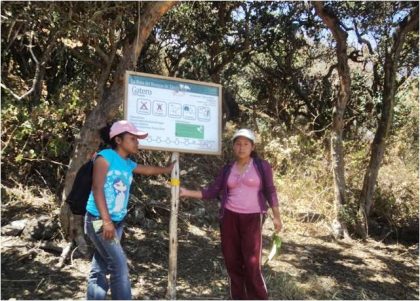 Location
Location
San Bartolomé, Huarochirí District, Lima Province, Perú
Community Description
San Bartolomé is a community of about 1,200 people located at the base of the western slope of the Andes Mountains, about 55 kilometers from Lima, at an altitude of 5,250 ft. The town’s extension is 54,335 m².
Water is scarce for domestic and agricultural use, and the principal source of income is the production of the tuna fruits, which grow atop the cactus Opuntia ficus índice (January- March). The production of cochinilla is also a prominent source of income, but an unpredictable market.
 A forested area (545 hectares) of the communally-owned land, known as Bosque de Zárate, is located in the upper watershed of the Rio Seco, an effluent to the Rio Rímac, Lima´s water source. The forest has a long history of visitors from Lima, but only lately has the community united to create plans to develop ecotourism around the reserve for the benefit of the community and to continue to conserve this dry Andean cloud forest.
A forested area (545 hectares) of the communally-owned land, known as Bosque de Zárate, is located in the upper watershed of the Rio Seco, an effluent to the Rio Rímac, Lima´s water source. The forest has a long history of visitors from Lima, but only lately has the community united to create plans to develop ecotourism around the reserve for the benefit of the community and to continue to conserve this dry Andean cloud forest.
Due to its importance as a source of water, the presence of endemic, threatened and newly discovered species, and the need to improve heavily degraded soils in the upper watershed from livestock, the forest was declared a national Reserved Zone in 2010. This progress is significant, but it requires the follow-through of education, infrastructure, and promotion of both conservation and sustainable development practices.
In order to ensure the long-term conservation of the Bosque de Zárate, it is imperative that the community develop the capacity to sustainably manage and administer natural resources through action and practice.
Project Description
This project is to build 2 rainwater harvesting systems, each with 2 rainwater barrels.
 This will be part of a demonstrative sustainability center just a 20-minute hike from the town center and at the entrance to the forest, where an Interpretive Center is currently under construction.
This will be part of a demonstrative sustainability center just a 20-minute hike from the town center and at the entrance to the forest, where an Interpretive Center is currently under construction.
In order to build capacity in integrated water resource management, and to demonstrate the advantages of rainwater harvesting, the community will locate 2 rain barrels at the Visitor´s Center and 2 barrels at the rangers´ cabin to collect and use rain that falls to the roof.
The reserve rangers will work with youth to develop a tree nursery for reforestation efforts and a bio-garden that will provide demonstrations of silviculture and hydroponic farming, soil conservation, and water infiltration techniques.
Lower elevations receive about 170 mm annually, while upper elevations receive about 340 mm, during just a few months of the rainy season. The overflow from these rain barrels will be directly routed to tree nurseries and a bio-garden, reducing erosion and improving water availability for reforestation and restoration efforts.
Project funds will be used for the purchase of rain barrels, hoses, valves, basket screens, gutters, downspout diverters, drip irrigation tape, cinder blocks, spigots, caulk, chains (to direct water into barrel from gutter), and Teflon tape
Recycled materials will be used whenever possible, and tools for construction will be provided by the community.
The project will be led by a group of 4 reserve rangers who receive payment from the Peruvian forest service, the Peace Corps Volunteer, and the president of the Comunidad Campesina.
An environmental club, Acciones Ambientales, consisting of youth and community members, and led by the aforementioned leaders, meets weekly and is dedicated to implementing the project. The construction will be carried out by high school students, with assistance from the members of the Comunidad Campesina, the communal owners of the land.
Maintenance will be carried out by reserve rangers, and visitors and students will be given the opportunity to assist with maintenance, observe rainwater collection, and gain an understanding of the importance of water collection and infiltration in the area.
Project Impact
1,000 town members will be exposed to integrated water management and land use techniques. 250 members of the Comunidad Campesina will support the project by providing land, tools, and support to youth. 138 high school students will be directly involved in experiential education of constructing rain barrels and rain gardens. 1,200 visitors annually will observe and learn about the practical purposes of rainwater collection.
Peace Corps Volunteer Directing Project
Maggie Messerschmidt
Comments
In addition to benefits to communal owners of the land, students, and visitors, this project will serve as a model to motivate and instruct others in techniques for rainwater capture as part of an integrated environmental approach.
Dollar Amount of Project
$524.00
Donations Collected to Date
$524.00
Dollar Amount Needed
$0.00 – This project has been fully funded, through the generosity of the Elmo Foundation.
We encourage others to continue to donate using the Donate button below, and we will notify the Peace Corps Volunteer of your donation. Additional funds will be used to fund the next project by the PCV and/or those of other PCVs in the country of service.
This project has been finished. To read about the conclusion of the project, CLICK HERE.